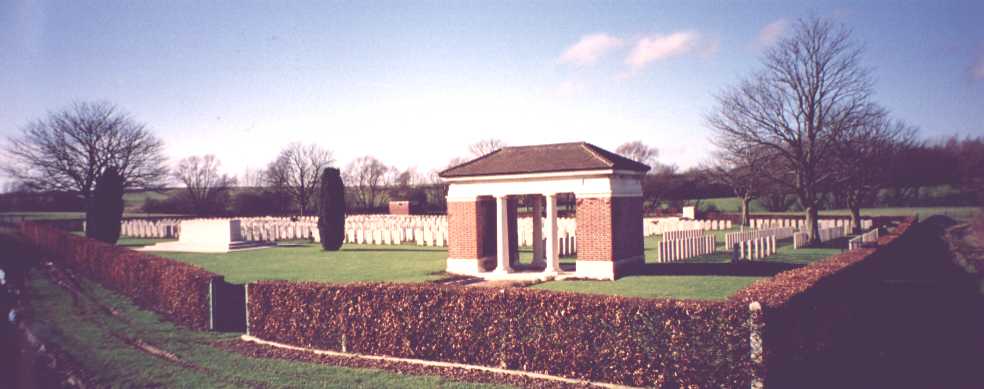

Fifteen
Ravine British Cemetery Villers-Plouich Nord, France |
Photo
© Lynne Brown 2003 |
Tuesday
21st January 2003
At last we found the final resting place of my grandfather Samuel Taylor, who
had been killed in the early hours of the Battle of Cambrai in 1917.
Arriving in the Belgian port of Zeebrugge on Tuesday morning, we had a fairly short drive on relatively quiet roads into France. The town of Cambrai, the battle for which was to cost Sam Taylor his life, was to be our base for two nights, and we arrived there in a little over two hours.
Two things both surprised and moved us on our journey. The first was the sheer number of military cemeteries. In every town and village we passed through there were numerous signs pointing the way to their local cemeteries, and most places seemed to have more than one of them. It was the first realisation that we were travelling through the area of some of the bloodiest fighting. Another thing which struck us was the fact that they were all very well maintained. Although I had seen many news items which showed the cemeteries in this condition, it was both surprising and pleasing to note that every one was the same. On our trip we were to see the care with which this work was carried out.
The first item on our agenda was to find a hotel in Cambrai. That didn't cause a problem at this time of the year, and by lunchtime we had checked in and were ready for what the trip was really about. After purchasing a couple of detailed maps of the area, we left Cambrai along the Avenue de la Victoire to join the N44 running south west from the town. Bearing right onto the D917, we soon came to the sign pointing right towards the small village of Villers-Plouich. In less than a kilometre we came to the cemetery itself. The usual Commonwealth War Graves Commission green sign pointed left down a narrow farm track to 'Fifteen Ravine British Cemetery'.
The Great Cross |
Fifteen Ravine takes its' name from an area marked on British Army maps of the time. As we had come to expect it's a beautifully maintained site (exactly as all the others we had passed en route) and is in a really quiet and peaceful location. We had previously looked at the Commonwealth War Graves Commisssion website and found the location of Sam's grave together with a plan of the cemetery. It wasn't strictly necessary because, as at all the locations we were to visit, all the information was on site anyway, and it took only a matter of minutes before we were standing in front of it. I can only say that it was a very moving experience and I am glad that Lynne and I had made the visit which my late mother had been unable to do.
|
It was a bright and sunny afternoon although very cold with a strong wind, but we spent quite a long time there wandering around the cemetery and returning periodically to Sam's grave. His army identity disk had been returned to my grandmother following his death, and I had taken it with me to France. It brought more of a personal touch to the occasion knowing that he had been wearing it at the time of his death more than 85 years ago. After taking lots of photographs and video film the time came for us to go, although we planned to return for a final time in a couple of days before making our way back to Zeebrugge. Before we did leave we signed the visitor's book and read through most of the earlier entries. As we were quite cold we decided to have a look at Villers-Plouich and take advantage of any cafe facilities which there may be, so it was back to the car and the very short drive to the tiny village. |
We were quite amused at first to find that a small square in the village was named 'Place de Wandsworth' after the London Borough of Wandsworth. Apparently this was due to the fact that the 'Wandsworth Pals' Battalion had spent much time in the area in 1917. They had taken the village in April of that year, during which operation one of their men was awarded the Victoria Cross, and they then spent the next few months defending it. After the war, Wandsworth Council was keen to maintain the links which had developed and in 1920 adopted Villers-Plouich which had been left totally devastated during the conflict. A public collection in Britain raised money to help with the village's rebuilding and strong ties between the two exist to this day. |
Villers-Plouiche
sketch by local artist. The town hall is in the foreground, with the Church
behind. |
The Council's link with this small village in northern France stretches back over 80 years. In 1919 the new Mayor of Wandsworth was quick to forge links with the community that the 13th East Surreys had freed from German occupation and where Corporal Foster had won his Victoria Cross (see photos). The British League of Help was a scheme whereby British towns and cities could 'adopt' and help to fund the restoration of a devastated French or Belgium community. On 25 September 1920 Wandsworth Council formally adopted Villers-Plouich, which had been left utterly ruined by the war. Some £1200 was collected from private donations and sent to the French mayor to assist with rebuilding. |